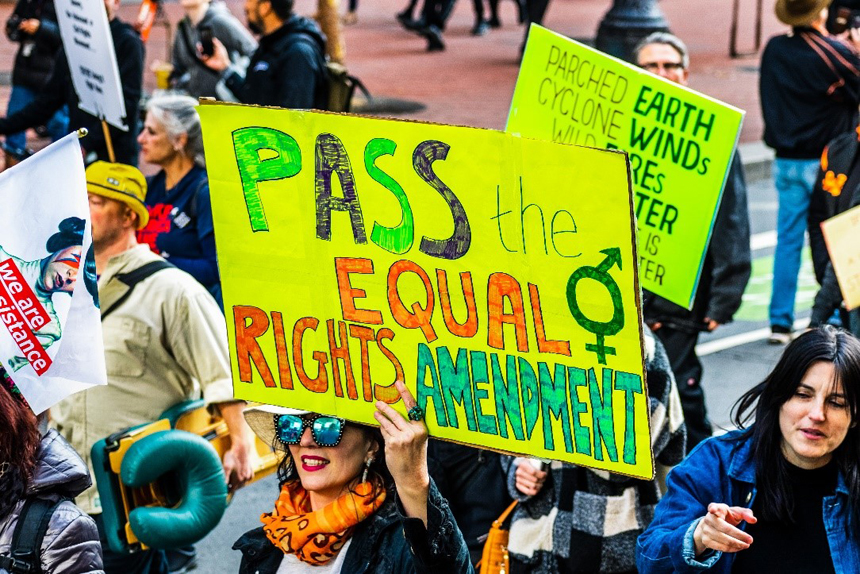After Congress passed the 19th Amendment in 1919, it took a little over a year for the states to ratify it. Now, with women able to vote, Alice Paul, head of the National Women’s Party, wanted to ensure their civil rights. A highly educated lawyer, Paul realized that the right to vote wouldn’t be enough to ensure equality for women.
So in 1923, she submitted a proposed amendment to Congress: “Men and women shall have equal rights throughout the United States and every place subject to its jurisdiction.”
The amendment had implications far broader than the right to vote; the women’s movement, which had championed suffrage, was divided on the issue. Some white voters saw it as a move toward an unwelcome equality with minority women. And some women workers believed it would take away the few workplace benefits they’d won. There was also legislative opposition. Emanuel Celler, a New York representative, blocked hearings on the ERA for 30 years.
In 1943, the amendment was revised to read, “Equality of rights under the law shall not be denied or abridged by the United States or by any State on account of sex.” This was the version that was introduced to every Congress until 1972, when it finally passed by overwhelming majorities: 93.4 percent in the House and 91.3 percent in the Senate.
With such strong Congressional support, backers of the amendment might have expected it would be quickly ratified by the states. But within the first year, only 22 of the 38 states required for ratification had done so.
Opposition to the amendment was raised by an Illinois lawyer named Phyllis Schlafly, who organized a STOP ERA campaign. She argued that the ERA would force women to go to war, and end child support and alimony. It would allow gay marriage, make women unfeminine, and cause society to fall apart.
She was part of a growing conservative movement in America that opposed the ERA. States’ rights advocates said the amendment was another attempt by the federal government to impose authority over state governments. Businesses like the insurance industry assumed ERA would cost them money. And fundamentalist religious groups vocally opposed what they considered a challenge to social and moral traditions.
As approved by Congress, the bill was given a seven-year deadline. But the rate of ratification had dropped off. Eight states ratified in 1973, three in 1974, and one each in 1975 and 1976.
With two years left in 1977, only 35 states had ratified the amendment, while five states — Nebraska, Tennessee, Idaho, Kentucky, and South Dakota — had voted to rescind their approval. The amendment was short by either 3 or 8 states, depending on whether the withdrawn ratifications were valid.
Time ran out in 1979, but Congress approved a two-year extension. Even with the extra time, the ERA still failed to receive the required number of ratifications. Meanwhile, conservative opposition was growing. Up to this point, both political parties had supported the amendment, but when Ronald Reagan was elected president in 1980, the Republican party withdrew its support.
For years, that’s where the matter rested. Then in 2017, 35 years after the original deadline, Nevada became the first state to ratify the ERA since 1977. It was followed by Illinois in 2018, and Virginia in 2020.
The number of states needed for ratification had crossed the threshold.
However, the Justice Department under the Trump administration said the deadline for ratification had passed and couldn’t be revived afterward. The amendment, they said, was “no longer pending before the States.” But in 2021, the House of Representatives voted to eliminate the deadline.
It’s the job of the Archivist of the United States to issue the certification that three-fourths of states have ratified the amendment, thus amending the Constitution. The recently departed archivist, David Ferriero, declined to certify, citing a Justice Department memo saying the amendment had expired. The current nominee, Colleen Shogan, told the Senate that she would need federal court or congressional confirmation that the ERA could be ratified before certifying it.
Several questions are left without definitive answers.
First, is the ERA still necessary to protect the rights of women?
Some legal scholars say the 14th Amendment protects equal rights for all. Others assert that it was intended principally to protect the privileges and immunities of recently freed slaves, although it could apply to women as well. But as the “separate but equal” ruling in Plessy vs. Ferguson showed, even the 14th Amendment is no guarantee of equal accommodations.
And, as Justice Antonin Scalia said in 2010, the Constitution, even with the 14th Amendment, does not protect women from gender-based discrimination.
And what about the deadline? Can Congress or the courts simply get rid of it?
Justice Ruth Bader Ginsburg pointed out that the time limit for ERA ratification was placed in the preamble to the amendment. The wording directed that the amendment would be part of the Constitution “when ratified.” The deadline wasn’t in the constitutional text, where it would be understood to set a firm deadline, like Section 3 of the 18th Amendment, which says, “This article shall be inoperative unless is shall have been ratified within seven years.”
What about the rescinding states? Does their withdrawn ratification count?
Article V of the Constitution only covers the states’ power to ratify an amendment. It says nothing about rescinding. When the 14th Amendment was before the states, two states rescinded their earlier ratification. Congress determined there was no legal validity to the withdrawn ratifications. But after all these years, can these rescissions be ignored?
Because there was so much controversy regarding deadlines, late ratifications, and withdrawn ratifications, Justice Ginsburg said, “I would like to see a new beginning. I’d like to start over.” But she added that validity of the ERA’s ratification is not an issue for the courts to decide; it is the responsibility of Congress to oversee, authorize, or reject the amendment.
The resolution that the House passed in 2021 to remove the deadline now sits in the hands of the Senate Judiciary Committee. On February 28 of this year, the Committee held a hearing for a joint resolution to remove the amendment’s deadline for ratification.
Senator Lisa Murkowski (R-AK) said, “Things have improved over the years, but we still have a long way to go to when it comes to achieving equality for women. And I think we need the Equal Rights Amendment to get there.” And Senator Ben Cardin (D-MD) said, “Now it is on Congress to recognize officially that 38 states have ratified the ERA and all constitutional requirements have been met.”
Senator Dick Durbin, who chairs the Committee, has said that a resolution will come to the Senate floor in the coming weeks. If it received 60 votes, it will move from debate to a full vote on passage.
Become a Saturday Evening Post member and enjoy unlimited access. Subscribe now




Comments
The ERA is not necessary, I feel it would not be of any benefit and would not give women anything they do not already have… perhaps it would hurt more tjan help. The Government we have today in America borders heavily on Fascism and Naziism – their focus is on control and globalism- they cannot be trusted to treat anyone equal – they only pursue EQUITY!
ERA is just crap, plain and simple and to put it mildly. It will never fly here in TN or other southern states. The feds are best to keep their noses out of our affairs. We enjoy a certain level of standard of living and we like our guns and the rights given to us with the 2nd Amendment.
All Congress and the government are out to do is destroy what’s left (as in what remains) of the U.S. Women definitely should have, and should have HAD equal rights going all the way back to the nation’s founding. Having said that, which never happened, at least since since women won the right to vote in 1920.
With the lowest of the low running this nation now, anything they’d do would make things worse for women, as they are for everyone else. dan c and deb webster, you make good points. Unfortunately you need to see what utter and complete garbage we have running America. The state of this nation speaks for itself: a s— show clown world.
be careful what you wish for. i confess that at this moment, i havent read the exact proposed amendment; but i wouldnt vote for it.
life, people, situations, abilities, differ: not the same. to allow all folks the same opportunities and levels of qualifications, is silly, dangerous, a waste of time and common sense.
the issue of men participating in womens sports is an obvious example. gender is a yuuge factor. men and women are not the same, physically. why compete as though they are? it is blind bigotry against women to say so.
*
many issues can be amended to support “equality;” others cannot, should not be. blending and blurring identities for the sake of “same,” destroys the concept of individuality.
men will never be women; women will not be men.
they are equal only in their separate qualities that do not equal each other.
*
it is the same for so many situations, groups, folks. in this country, individuality matters; differences shine. part of an e.r.a., is about abolishing unique characteristics. thats not what america stands for.
let folks excel in their differences, as well as their sameness. dont throw the baby out with the bathwater.
I think the idea of this (or any) amendment being considered ratified when if only reached the required 38 states 39 years after the deadline to ratify is ludicrous. The assertion that the deadline doesn’t count because of it being in the preamble amounts to semantic sophistry. And what about the five recissions??? Hmm? That said, let’s also not forget that an amendment cannot be sent to the states by Congress for ratification without a two-thirds vote in favor by both houses of Congress. So any attempt to ignore that inconvenient deadline by wishful thinkers would be ever more preposterous if such an attempt was passed with anything less but two-thirds support by both houses.